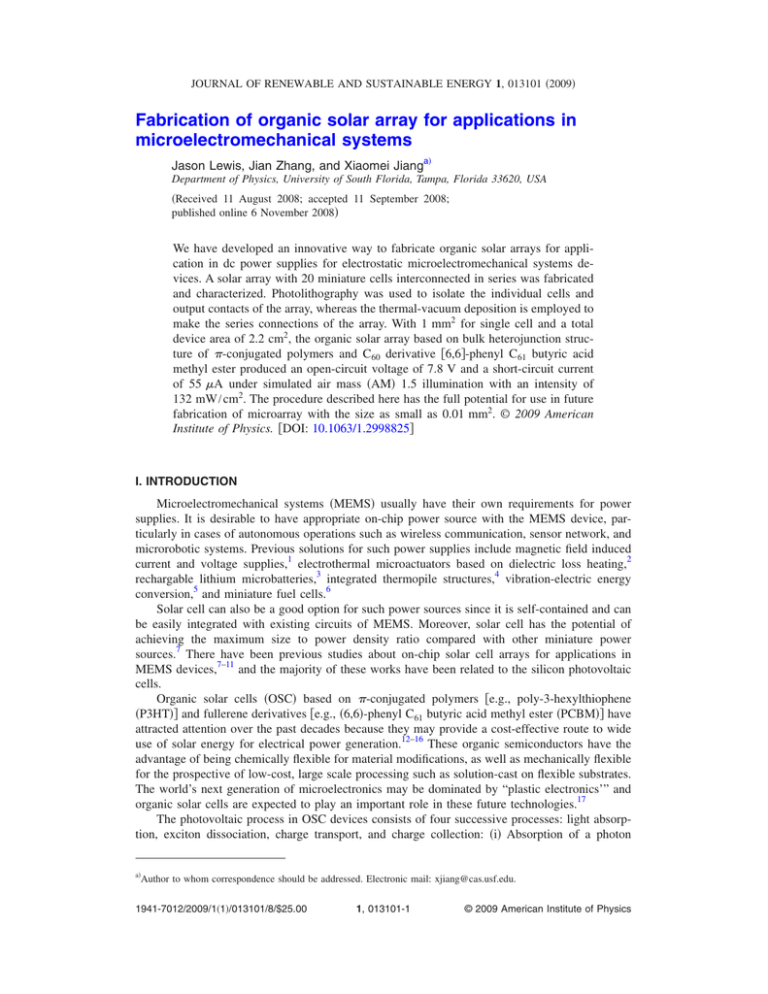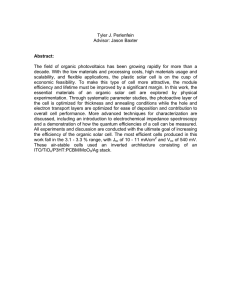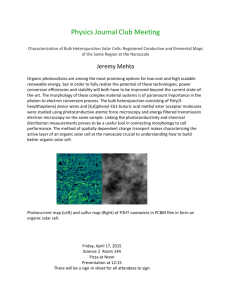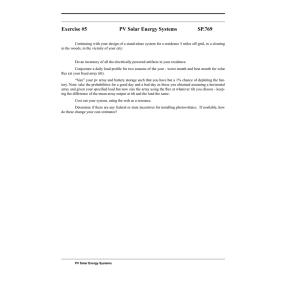Fabrication of organic solar array for applications in
advertisement

JOURNAL OF RENEWABLE AND SUSTAINABLE ENERGY 1, 013101 共2009兲 Fabrication of organic solar array for applications in microelectromechanical systems Jason Lewis, Jian Zhang, and Xiaomei Jianga兲 Department of Physics, University of South Florida, Tampa, Florida 33620, USA 共Received 11 August 2008; accepted 11 September 2008; published online 6 November 2008兲 We have developed an innovative way to fabricate organic solar arrays for application in dc power supplies for electrostatic microelectromechanical systems devices. A solar array with 20 miniature cells interconnected in series was fabricated and characterized. Photolithography was used to isolate the individual cells and output contacts of the array, whereas the thermal-vacuum deposition is employed to make the series connections of the array. With 1 mm2 for single cell and a total device area of 2.2 cm2, the organic solar array based on bulk heterojunction structure of -conjugated polymers and C60 derivative 关6,6兴-phenyl C61 butyric acid methyl ester produced an open-circuit voltage of 7.8 V and a short-circuit current of 55 A under simulated air mass 共AM兲 1.5 illumination with an intensity of 132 mW/ cm2. The procedure described here has the full potential for use in future fabrication of microarray with the size as small as 0.01 mm2. © 2009 American Institute of Physics. 关DOI: 10.1063/1.2998825兴 I. INTRODUCTION Microelectromechanical systems 共MEMS兲 usually have their own requirements for power supplies. It is desirable to have appropriate on-chip power source with the MEMS device, particularly in cases of autonomous operations such as wireless communication, sensor network, and microrobotic systems. Previous solutions for such power supplies include magnetic field induced current and voltage supplies,1 electrothermal microactuators based on dielectric loss heating,2 rechargable lithium microbatteries,3 integrated thermopile structures,4 vibration-electric energy conversion,5 and miniature fuel cells.6 Solar cell can also be a good option for such power sources since it is self-contained and can be easily integrated with existing circuits of MEMS. Moreover, solar cell has the potential of achieving the maximum size to power density ratio compared with other miniature power sources.7 There have been previous studies about on-chip solar cell arrays for applications in MEMS devices,7–11 and the majority of these works have been related to the silicon photovoltaic cells. Organic solar cells 共OSC兲 based on -conjugated polymers 关e.g., poly-3-hexylthiophene 共P3HT兲兴 and fullerene derivatives 关e.g., 共6,6兲-phenyl C61 butyric acid methyl ester 共PCBM兲兴 have attracted attention over the past decades because they may provide a cost-effective route to wide use of solar energy for electrical power generation.12–16 These organic semiconductors have the advantage of being chemically flexible for material modifications, as well as mechanically flexible for the prospective of low-cost, large scale processing such as solution-cast on flexible substrates. The world’s next generation of microelectronics may be dominated by “plastic electronics’” and organic solar cells are expected to play an important role in these future technologies.17 The photovoltaic process in OSC devices consists of four successive processes: light absorption, exciton dissociation, charge transport, and charge collection: 共i兲 Absorption of a photon a兲 Author to whom correspondence should be addressed. Electronic mail: xjiang@cas.usf.edu. 1941-7012/2009/1共1兲/013101/8/$25.00 1, 013101-1 © 2009 American Institute of Physics J. Renewable Sustainable Energy 1, 013101 共2009兲 013101-2 creates an exciton 共bounded electron-hole pair兲; 共ii兲 the exciton diffusion to a region 共for instance, the interface of two different components兲, where exciton dissociation 共or charge separation兲 occurs; 共iii兲 finally, free charges move separately toward the anode 共holes兲 and cathode 共electrons兲, where 共iv兲 they are collected. Several parameters determine the performance of a solar cell, namely, the open-circuit voltage 共Voc兲, short-circuit current 共Isc兲, and the so-called fill factor 共FF兲. FF is calculated by FF = ImpVmp , IscVoc 共1兲 where Imp and Vmp are the current and voltage operating points for maximum power, respectively. The overall power conversion efficiency is defined as = ImpVmp FF · IscVoc = . Pin Pin 共2兲 Although the current power conversion efficiency 共about 6%兲 of OSC is still not high enough to make it a practical solution for large scale commercial applications as general electric power sources, it is promising to use OSC as a high-voltage power supply. The open-circuit voltage of single junction OSC 共Voc = 0.6–0.7 eV兲 is close to that of the single crystal Si or thin film polycrystalline Si.8 For many electrostatic MEMS, it is more critical to have high-voltage output 共from tens to hundreds of volts兲 rather than high current or energy efficiency, with an operatable current range usually falling between nanoamperes to microamperes. According to the design criteria of such on-chip solar cells,8 OSC based on -conjugated polymers and fullerene derivatives is an excellent choice. First of all, isolation of the solar cell array from the MEMS substrate is easy to achieve, since OSC can be fabricated on any substrate including plastic. This also makes the integration with microsensors and microactuators relatively effortless. Second, these polymers are efficient light absorbers 共with a typical absorption coefficient several orders higher than that of the conventional semiconductors such as Si兲, meaning the active layer can be as thin as 100 nm, which makes it simple for series interconnection to produce high voltage. Third, Voc of a single cell of these OSCs can be easily tuned as high as 0.87 V by chemical tailoring of both constituents.18 Fourth, the photoactive layer can be made through any solution processable fabrication methods 共i.e., spin-coating, spraying, and inkjet printing兲 without the need of photolithography, which is mandatory with silicon-related fabrication process. These OSC can be manufactured on plastic substrates, making these cells lightweight, flexible, and very cost-effective. The usual drawbacks of OSC 共e.g., lower short-circuit current and power conversion efficiency兲 are not the major issues for using them as on-chip dc power sources, making OSC a perfect solution for MEMS inertia transducers, such as resonator, accelerometer, gyroscope, and pressure sensors.19 To the best of our knowledge, there has been no report of organic solar arrays based on P3HT and PCBM as MEMS power sources. Although there have been previous studies on large area organic solar modules.20–23 A small 共2.2 cm2兲 photovoltaic minimodule having 20 cells in series was reported in this article. The anode is made by patterning indium tin oxide 共ITO兲 on glass by photolithography, the cathode is made by thermal evaporation through a metal shadow mask, which simultaneously accomplishes the series connection of all cells. The active layer material used in our process is a blend of P3HT and PCBM, which forms a bulk heterojunction structure. In this report, a detailed array fabrication process and the characterization of both single cell and interconnected solar array are present. In the end, a brief discussion will be given about the factors that could affect the output voltage and overall power efficiency, as well as several tentative solutions for short-circuit problems within the array. Our research has focused on the design of a process to ensure full isolation of series connected cells, and this process has the full potential for use in future fabrication of a microarray with a size as small as 0.01 mm2. 013101-3 Organic solar array as MEMS power source J. Renewable Sustainable Energy 1, 013101 共2009兲 FIG. 1. 共a兲 Enlarged drawing of the anode, cathode, and sandwich structure of single cell with area of 1 mm2. 共b兲 Illustration of the interdigitated organic solar cell array consisted of 20 single cells. The bottom 共light purple兲 layer is photolithography-defined ITO anode, the middle 共red兲 layer is spin-coated P3HT:PCBM, and the top 共light blue兲 layer is thermal deposited cathode by shallow mask technique. II. FABRICATION PROCESS The first step was the design of the solar array. The ability to align the substrate with the shadow mask by eye in the inert environment as well as other process parameters were considered before a final geometric design was made for the array. Figure 1 shows such an array consisting of 20 single cells. The top panel of Fig. 1 presents details of each cell. The whole fabrication process consists of four steps. A. Patterning of the anode ITO coated glass substrates 共⬎85% transmittance, 5 – 15 ⍀ / 䊐兲 were purchased from Delta Technology Inc. and cut into 1 in.⫻ 1 in. pieces. The patterning of ITO is done via standard photolithography using a custom made photomask, as shown in Fig. 1 共light purple兲. The photomask was made by printing the desired pattern on one plastic transparency and taped onto a piece 013101-4 J. Renewable Sustainable Energy 1, 013101 共2009兲 FIG. 2. The fabrication process of miniature solar cell array. Start from 共1兲 a clean ITO on glass substrate, followed by 共2兲 spin-coating photoresistance, 共3兲 development of desired pattern by photolithography, 共4兲 etching off the unwanted ITO, 共5兲 washing off the photoresistance, 共6兲 spin-coating active layer 共P3HT:PCBM兲, 共7兲 clean off excessive material, 共8兲 deposit cathode via shadow mask. of 5 in.⫻ 5 in. glass. Positive photoresist 共Shipley 1813兲 is spun-coat onto the ITO side of the substrate at a rate of 4500 rpm for 45 s, creating a layer with thickness of about 1.5 m. The substrate is then soft baked on a 90 ° C hotplate for 90 s, followed by a 3 s exposure to UV light through the photomask, and the substrate is then developed in Shipley MF319 for about 1 min, followed by a hard bake at 150 ° C for 10 min. Etching of the ITO was done in a mixed solution of HCl and HNO3. The patterned ITO substrate then undergoes sonification cleaning in trichloroethylene, acetone, and isopropanol at 50 ° C for 20 min each, followed by drying with N2. The glass substrate now has the desired pattern of ITO, which acts as the anode part of the solar array. B. Creation of the shadow mask A 1 in.⫻ 1 in. piece of stainless steel was patterned following a similar photolithography procedure described above. Etching of the photoresist coated stainless steel was done using a diluted ferric chloride 共FeCl3兲 solution 关25% in deionized 共DI兲 water兴 for 2 h. The patterned shadow mask 共Fig. 1, light blue兲 was rinsed by DI water and sonification in acetone and isopropanol at 50 ° C for 20 min. C. Formation of the photoactive layer The original aqueous poly共3,4ethylenedioxythiophene兲:poly共styrenesulfonate兲 共PEDOT:PSS兲 共Baytron 500兲 obtained from H. C. Starck was diluted and filtered three times, then filtered out through a 0.45 m filter. The solution is then spun coat on top of the patterned ITO at a rate of 5000 rpm for 90 s after which the substrate is then heated up to 120 ° C for 100 min. P3HT and PCBM were purchased from American Dye Source Inc. The active layer solution is made by mixing P3HT and PCBM with a weight ratio of 1:1 in chloroform, then spun-coat on top of the PEDOT:PSS coated substrate at a rate of 700– 800 rpm for 90 s. This provides a thickness of 013101-5 Organic solar array as MEMS power source J. Renewable Sustainable Energy 1, 013101 共2009兲 FIG. 3. Upper panel: schematic of a single organic solar cell with bulk heterojunction structure. Lower panel: currentvoltage characteristics of single cell made with P3HT:PCBM mixed with weight ratio of 1:1 under simulated AM1.5G, radiation at 132.6 mW/ cm2. The active layer was spun-coat on patterned ITO substrate at 800 rpm, with a final thickness of about 200 nm. Post-device thermal annealing at 120 ° C for 5 min was done before the I-V measurements. 200 nm. The excess film is then wiped off in order to allow the aluminum to make the series connections required for the device 共Fig. 1兲. The sample is then allowed to dry for a minimum of 3 h in vacuum before thermal evaporation of the cathode. D. Deposition of the cathode In order for the device to function as a series array, the patterned shadow mask must be precisely aligned to the ITO substrate 共see Fig. 1兲. With the alignment done the substrate is then fixed onto the chuck and loaded into the deposition chamber. Aluminum was chosen for the cathode due to its desirable work function 共for collection of electrons兲 and cost-effectiveness. Deposition of aluminum was done under high vacuum 共⬎10−7 torr兲, with a final thickness of 100 nm. Device fabrication is completed with a final annealing on a hotplate at 110 ° C for 5 min in the glove box, prior to the I - V measurements. Figure 2 illustrates the fabrication process for the organic solar array. The active layer is spun-coat from a chloroform solution of P3HT:PCBM blend with a weight ratio of 1:1. 013101-6 J. Renewable Sustainable Energy 1, 013101 共2009兲 FIG. 4. 共a兲 A digital picture of the organic solar array with 20 miniature cells in series, 共b兲 current-voltage curve of an organic solar array with nine functioning cells measured at simulated AM1.5G with radiation of 132.6 mW/ cm2. The fabrication parameters are the same as single cell 共in Fig. 3兲. The inset shows array Voc as a function of number of cells in series. An output voltage of 7.8 V was achieved with 18 cells in series. III. EXPERIMENTAL RESULTS In order to examine the solar array fabrication procedure described above and find the operational parameters for various processes, we fabricated test OSC in a simpler geometry consisting of four single cells, each has an active area of 4 mm2 共Fig. 3 upper left panel兲. The upper right panel of Fig. 3 shows the side view of each cell in bulk heterojunction structure. Preliminary optimization was performed in terms of spin rate and thermal annealing conditions. The best performed single cell was fabricated with an active layer thickness of 200 nm followed by a post-device thermal annealing at 120 ° C for 5 min. The current-voltage 共I - V兲 characterization of the solar cells was performed on a solar simulator consisting of a xenon arc lamp 共Oriel 66485兲 and an air mass 共AM兲 1.5 global filter 共Oriel 81094兲 with irradiation of 132.6 mW/ cm2. No spectral mismatch with the standard solar spectrum 013101-7 Organic solar array as MEMS power source J. Renewable Sustainable Energy 1, 013101 共2009兲 TABLE I. Summary of device parameters for three organic solar cell arrays containing different numbers of cells in series. The current voltage characteristics in dark and under simulated solar AM1.5 with an intensity of 132.6 mW/ cm2 are present. Each cell has an active area of 1 mm2. The power conversion efficiency 共兲 was calculated using Eq. 共2兲 in text. Active layer thickness 共nm兲 Number of cells in series Voc 共V兲 Isc 共mA兲 Jsc 共mA/ cm2兲 FF 共%兲 Array 1 Array 2 203 202 9 15 5.2 7.0 0.0545 0.0245 0.605 0.163 0.32 0.17 0.76 0.15 Array 3 232 18 7.8 0.0135 0.075 0.13 0.06 Array name AM 1.5 共with an intensity of 132 mW/ cm2兲 was corrected in the I - V characterization. The best of such single devices has a short-circuit current density Jsc = 12.7 mA/ cm2, open-circuit voltage Voc = 0.60 V, FF = 0.43, and a power conversion efficiency of 2.45% 共Fig. 3 lower panel兲. While this modest efficiency certainly has room to be improved by nanomorphology manipulations,15,16 the main purpose herein is to find the right parameters for each fabrication process. Using these appropriate parameters, organic solar cell array based on the same photoactive material 共P3HT and PCBM blend兲 used above was fabricated according to the fabrication procedure described in Sec. II. The interconnected series consists of 20 cells each with active area of 1 mm2 on a 1 in.2 ITO substrate. A picture of such an array is shown in Fig. 4共a兲. Figure 4共b兲 shows the I - V curve of the best performed array 共array 1 in Table I兲. Though extra caution and efforts have been made to avoid short circuits among individual cells, the alignment of shadow mask with the ITO anodes inside the glove box turned out to be very challenging, especially when the active layer is thin 共⬍200 nm兲. Not-so-perfect alignment resulted in “shadow effect,” which smeared out the contact to neighboring cells, causing unintentional lateral connection. In this preliminary work, we also tried to increase the active layer thickness to see how it would help with short circuits of individual cells. Table I gives a summary of three solar arrays with different active layer thicknesses. It can be seen that, with thicker film, a smaller number of cells was short circuited. The inset of Fig. 4共b兲 plots the array Voc versus the number of cells in series, and a linear relation is shown; for a total of 18 minicells, the measured Voc is 7.8 V. Although the overall device performance is less impressive, and the poor FF might be due to increased lateral collection, causing the increase of series resistance 共Rs兲 of the solar array.11 The more important point is the capability to obtain larger Voc in terms of the application for dc power supply. Our prefactory results demonstrate the potential to easily tune the output voltage by the number of cells in series. Further improvement of the array performance is ongoing to determine the optimization of active layer thickness and nanomorphology, as well as to reduce Rs of the array device by means of thermal annealing and modifying the contact properties between active layer and the electrodes. IV. CONCLUSION In conclusion, a miniature organic solar array was designed, fabricated, and characterized for application in MEMS device power supplies. The photoactive layer was formed by spin coating a thin film of -conjugated polymer P3HT and fullerene derivative PCBM blend mixed in chloroform. The electrodes were patterned by photolithography and thermal evaporation through a patterned shadow mask. An output voltage of 7.8 V and short-circuit current as large as 55 A under simulated solar AM1.5 illumination were achieved with the small array device 共2.2 cm2兲. 013101-8 J. Renewable Sustainable Energy 1, 013101 共2009兲 ACKNOWLEDGMENTS The authors are grateful for the financial support from USF Grant No. GFMMD03, ACS Petroleum Research Fund 共PRF 47107-G10兲 and the U.S. Department of Army USAMRMC Grant No. W81XWH-07-1-0708. We would also like to acknowledge Robert Tufts and Richard Everly for their help with USF NNRC facilities and training. H. Matsuki, M. Yamaguchi, T. Watanabe, and K. Murakami, J. Appl. Phys. 64, 5859 共1988兲. B. Rashidian and M. G. Allen, in Proceedings of the 6th IEEE Workshop on Micro Electro Mechanical Systems, Fort Lauderdale, FL, February 1993 共IEEE, Piscataway, NJ, 1993兲, p. 24. 3 J. B. Bates, G. R. Gruzalski, and C. F. Luck, in Proceedings of the 6th IEEE Workshop on Micro Electro Mechanical Systems, Fort Lauderdale, FL, February 1993 共IEEE, Piscataway, NJ, 1993兲, p. 82. 4 Z. Olgun, O. Akar, H. Kulah, and T. Akin, in Proceedings of the Transducers 97, International Conference on Solid-State Sensors and Actuators 共IEEE, New York, 1997兲, p. 1263. 5 S. Meninger, J. O. Mur-Miranda, R. Amirtharajah, A. Chandrakasan, and J. Lang, in Proceedings of the 1999 International Symposium on Low Power Electronics and Design 共IEEE, New York, 1999兲, p. 48. 6 A. Jansen, S. van Leeuwen, and A. Stevels, in Proceedings of the 2000 IEEE International Symposium on Electronics and the Environment 共IEEE, Piscataway, NJ, 2000兲, p. 155. 7 P. Ortega, S. Bermejo, and L. Castañer, IEEE Trans. Compon., Packag. Manuf. Technol., Part B 24, 169 共2001兲. 8 J. B. Lee, Z. Chen, M. G. Allen, A. Rohatgi, and R. Arya, J. Microelectromech. Syst. 4, 102 共1995兲. 9 S. Bermejo and L. Castañer, in Proceedings of the 19th European Photovoltaic Solar Energy Conference and Exhibition, Paris, France, 2CV.2.69, 2004, p. 135. 10 M. A. Kroon, R. A. C. M. M. van Swaaij, and J. W. Metselaar, in Proceedings of the 16th European Photovoltaic Solar Energy Conference 共James & James 共Science Publishers兲 Ltd., London, 2000兲, p. 486. 11 S. Bermejo, P. Ortega, and L. Castañer, Prog. Photovoltaics 13, 617 共2005兲. 12 G. Yu, J. Gao, J. C. Hummelen, F. Wudl, and A. J. Heeger, Science 270, 1789 共1995兲. 13 S. E. Shaheen, C. J. Brabec, N. S. Sariciftci, F. Padinger, T. Fromherz, and J. C. Hummelen, Appl. Phys. Lett. 78, 841 共2001兲. 14 M. M. Wienk, J. M. Kroon, W. J. H. Verhees, J. Knol, J. C. Hummelen, P. A. van Hal, and R. A. J. Janssen, Angew. Chem., Int. Ed. 42, 3371 共2003兲. 15 W. Ma, C. Yang, X. Gong, K. Lee, and A. J. Heeger, Adv. Funct. Mater. 15, 1617 共2005兲. 16 M. Reyes-Reyes, K. Kim, and D. L. Carroll, Appl. Phys. Lett. 87, 083506 共2005兲. 17 G. Dennler and N. S. Sariciftci, Proc. IEEE 93, 1429 共2005兲. 18 F. B. Kooistra, J. Knol, F. Kastenberg, L. M. Popescu, W. J. H. Verhees, J. M. Kroon, and J. C. Hummelen, Org. Lett. 9, 551 共2007兲. 19 N. V. Lavrik, M. J. Sepaniak, and P. G. Datskos, Rev. Sci. Instrum. 75, 2229 共2004兲. 20 S. Yoo, W. J. Potscavage, B. Domercq, J. Kim, J. Holt, and B. Kippelena, Appl. Phys. Lett. 89, 233516 共2006兲. 21 F. C. Krebs, H. Spanggard, T. Kjær, M. Biancardo, and J. Alstrup, Mater. Sci. Eng., B 138, 106 共2007兲. 22 C. Lungenschmied, G. Dennler, H. Neugebauer, S. N. Sariciftci, M. Glatthaar, T. Meyer, and A. Meyer, Sol. Energy Mater. Sol. Cells 91, 379 共2007兲. 23 M. Niggemann, B. Zimmermann, J. Haschke, M. Glatthaar, and A. Gombert, Thin Solid Films 516, 7181 共2008兲. 1 2


